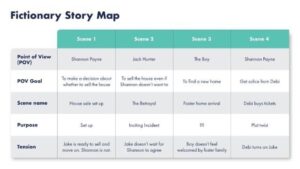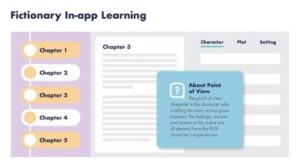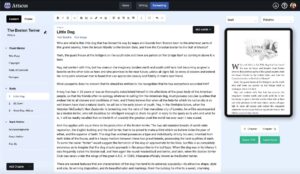
From the humble pen and paper, to the mighty typewriter, and now the omnipresent computer, the art of writing has always danced beautifully with the rhythm of technology. And now, it’s all about the best apps for writers.
Today, a writer without their digital toolbox is like a sailor braving the seas without a compass. Yeah, you could do it old school, but why wrestle with the winds when you can harness them to sail smoothly?
So, whether you’re penning the next brilliant novel, wrestling with syntax for a killer blog post, or crafting interesting copy, there are a plethora of apps for writers available to lend a hand. Think of them as your digital muses, providing inspiration when the going gets tough and smoothing out the rough edges of your writing journey.
In this article, we’ll explore our top five picks for the best apps for writers in 2023, each chosen for their exceptional prowess in a particular area of writing:
- Fictionary: Our top pick for fiction writers. It’s like having a best-selling author looking over your shoulder, pointing out all the things you’re doing right (and a few things to reconsider).
- ProWritingAid: The ultimate companion for grammar, spelling, and style. It’s not just an app, it’s your personal editor-in-chief keeping your prose sharp and your metaphors even sharper.
- Atticus: The dream app for self-publishing authors. It turns the confusing, maze-like process of formatting into a walk in the park. And who doesn’t love a nice, stress-free stroll through the park?
- World Anvil: The one-stop-shop for world-building. It’s like a 3D printer for your imagination, helping you craft intricate worlds with the same ease as writing a grocery list.
- Final Draft: A screenwriter’s best friend. It takes the daunting job of script formatting and transforms it into a breezy afternoon task.
Buckle up, fellow writers, we’re about to embark on an exciting journey through the landscape of these top-tier apps for writers. So, grab your coffee (or tea, no judgement here), sit back, and let’s dive right in!
Fictionary: Best App for Fiction Writers
The Benefits of Using Fictionary

The thrill of writing ‘The End’ on a first draft is a feeling akin to scaling a mountain, gazing upon the vast landscape of words you’ve created.
But seasoned writers know that this is just the base camp of the Everest-like journey known as developmental (or story) editing. This phase of refining the plot, pacing, and character development can often feel like trying to assemble a 1000-piece jigsaw puzzle without the box lid.
It’s easy to feel overwhelmed by the magnitude of the task, and even easier to lose sight of the narrative arc amidst the forest of individual scenes and chapters.
That’s where Fictionary, as one of the best apps for writers, swoops in like a superhero, ready to save your novel and your sanity.
Fictionary is a powerful app designed specifically to tackle the challenges of story editing, turning the process from an imposing mountain climb into a manageable molehill.
Let’s look at a summary of the ways Fictionary works its magic, before we delve into its specific features:
Story Arc Visualisation
It’s easy to lose track of the big picture when you’re in the mucky trenches of editing.
Fictionary provides a clear, visual representation of your story arc, allowing you to spot pacing issues, narrative gaps, or misplaced plot points at a glance. It’s like having a GPS for your storyline, helping you navigate the peaks and valleys of your plot with ease.
Character Consistency
Maintaining consistent character attributes and motivations throughout your novel is a crucial aspect of creating believable characters. Fictionary makes it easy to track character development, ensuring that your characters remain true to themselves and their journey throughout your narrative.
In-depth Scene Analysis
Each scene is a building block of your novel, and it’s essential to ensure that each one contributes to the overall narrative. Fictionary helps you scrutinise each scene for its purpose and effectiveness, ensuring that every piece of the puzzle fits perfectly into the overall picture.
Automated Feedback
Fictionary provides automated feedback based on established writing standards, saving you countless hours of self-editing and second-guessing. It’s like having an objective, impartial editor by your side, pointing out potential improvements with no risk of bruising your writer’s ego.
Learning Opportunities
Fictionary is not just a one of the best apps for writers. It’s a mentor. The app provides resources and tips to improve your craft, turning each editing session into a learning experience.
Using Fictionary is like strapping on a jetpack for your journey through story editing.
It doesn’t just make the process faster and easier. Oh no, my writerly friend! It also makes it more enjoyable. It allows you to focus on the joy of crafting your narrative rather than getting bogged down in the minutiae of story editing.
Fictionary is an invaluable ally for any fiction writer. It understands the challenges you face, and it’s here to help you overcome them.
With Fictionary at your side, story editing becomes less of a hair-pulling slog, and more of an enjoyable journey, leaving you more time to do what you do best–writing stories readers love. So, why not give Fictionary a whirl and experience the benefits yourself?
You might just find that it’s the writing partner you’ve been looking for!
Key Features of Fictionary as One of the Bests Apps for Writers
The Automated Story Arc

If you’ve ever attempted plotting out your story arc using sticky notes or a spreadsheet, you know it’s about as fun as trying to marshal cats while blindfolded. Not to mention, it’s easy to lose sight of the bigger picture when you’re drowning in a sea of plot points and character arcs.
That’s where Fictionary’s Automated Story Arc feature comes in.
This clever feature takes the guesswork (and the manual labour) out of story arc creation. It’s like having an editorial assistant who works tirelessly to map out your narrative structure while you sit back and enjoy your favourite writing snack of choice!
Here’s how it works.
The Automated Story Arc feature analyses your manuscript and auto generates a visual representation of your story arc. It highlights these key plot points:
● The Inciting Incident
● Plot Point 1
● The Middle Event
● Plot Point 2
● The Climax
This exceptional feature allows you to see at a glance whether your story follows an interesting and cohesive structure.
But it doesn’t stop there.
It also checks whether your story aligns with tried-and-true storytelling structures, like the three-act structure or the hero’s journey. If your story veers off course, Fictionary gently nudges you back on track with suggestions for improvement.
Basically, the software ensures you don’t get lost in the wilderness of your own creativity.
The beauty of the Automated Story Arc feature is that it saves you time and mental energy. It provides an objective, bird’s-eye view of your story, freeing you up to focus on the fun part. The writing. Plus, it’s a great learning tool, helping you understand narrative structure in a hands-on, practical way.
In a nutshell, Fictionary’s Automated Story Arc is a lifesaver for anyone who’s ever grappled with the challenge of plotting an interesting story.
The Story Map

Every writer knows that sinking feeling when you realise there’s a hole in your plot big enough to drive a truck through. Or worse, when you discover that your timeline is more twisted than a pretzel.
These are the kinds of problems that can derail your story faster than you can say, “Wait, what happened to that subplot about the mysterious locket?”
Enter the Fictionary Story Map, one of the best apps for writers features on the market!
This feature is like having a detective on your writing team sniffing out problems in your story before they turn into a full-blown crisis. It’s a sense check for your manuscript, highlighting areas that need your attention.
The Story Map captures every Story Element in one place, giving you a panoramic view of your story.
This is a bird’s-eye view of your narrative landscape.
You can see at a glance where the story flows smoothly and where it gets bogged down. You can spot those slow segues where nothing much seems to happen, or where the POV goals aren’t clear.
But the genuine beauty of the Story Map is how it helps you find and fix those pesky timeline issues.
You know the ones: that flashback that somehow ended up in the future, or that character who seems to be in two places at once. With the Story Map, you can untangle your timeline and ensure that your story unfolds in a logical and engrossing sequence.
The Story Map is not just a diagnostic tool, but also a guide to improving your story. It shows you where to ramp up the tension and conflict, and where you might need to use more sensory details. The Story Map pushes you to tighten your plot, deepen your characters, and sharpen your settings.
In short, the Fictionary Story Map is your secret weapon against plot holes, confusing timelines, and lacklustre scenes. It’s the spotlight that illuminates the dark corners of your manuscript, helping you create a story that’s as flawless as a perfectly cut diamond.
In App Learning

Imagine you’re writing a novel, and you’re speeding along like a train…
Suddenly, you hit a roadblock.
You’re not sure what POV means, or how to differentiate between backstory and flashbacks. You feel you’ve walked into a cocktail party where everyone’s speaking a foreign language. All that jargon and writing technique terminology can intimidate, and before you know it, you’ve got a full-blown case of writer’s block.
But don’t fear!
Fictionary’s In-App Learning is here to save the day, which makes it stand out from other apps for writers. What if you had a seasoned author or a writing coach sitting right beside you, explaining every concept, answering every question, and helping you navigate the labyrinthine world of writing?
That’s what Fictionary’s In-App Learning is like.
As you bravely quest through your story edit, you’ll find a treasure trove of information and resources built into the app. Each element comes with a handy guide, explaining what it is, why it’s important, and how to use it effectively in your story. It’s like having your personal encyclopaedia of writing techniques, right at your fingertips.
Not sure what a POV Goal is? Click the little blue question mark next to the POV Goal Element and… BAM! Advice on POV Goals pops up, breaking it down for you. Confused about the difference between backstory and flashbacks? Voila! There’s a detailed explanation, complete with examples.
But the real magic of Fictionary’s In-App Learning is how it makes you a better writer.
It’s not just about understanding the techniques. If only. It’s about learning how to apply them to your own work. As you edit, you learn, and as you learn, you improve. It’s like a two-for-one deal.
You get a polished manuscript and a masterclass in writing.
Like all the best apps for writers, Fictionary takes the mystery out of the writing process, breaking it down into manageable, bite-sized chunks.
It’s like having a writing tutor on speed dial, ready to demystify the craft and guide you to becoming a more skilled and confident writer. So, next time you hit a roadblock, don’t panic.
Fictionary’s In-App Learning has got you covered.
Progress Tracking
![]()
We’ve all been there.
You’re knee-deep in the editing process, and you look up and think, “Wait a minute, how much further do I have to go? Am I almost done? Or am I just sprinting in place like a hamster on a wheel?”
Let’s face it, keeping track of your story editing progress can feel like trying to solve a Rubik’s cube in the dark.
Fictionary’s Progress Tracking feature, however, is like a lighthouse guiding you through the foggy sea of story editing. It keeps a precise record of your journey through the labyrinth of character, plot, and setting elements for every scene. You’ll never have to guess how far you’ve come or how much further you need to go.
This feature shows you exactly where you are, how far you’ve travelled, and when you’ve reached your destination.
Once you’ve filled out all the elements for every scene, you can confidently say, “I’m done!” Your story is now ready to meet the world, whether you’re querying prospective agents or enlisting the eagle eyes of a professional editor before self-publishing.
But wait, there’s more!
Fictionary doesn’t just track your progress, it also shows it to you.
The Visualise tab in the Fictionary app gives you a visual representation of your journey. It’s like your personal progress report card, updating in real time as you work through your manuscript.
Editing can often feel like going ten rounds with a pro kickboxer, but with Fictionary’s Progress Tracking, you’ll always know where you are, which makes it one of the best apps for writers. It’s your personal trail guide, ensuring that you never lose your way in the wilds of manuscript editing.
Remember, every journey begins with a single step, and with Fictionary’s Progress Tracking, you’ll never lose count of those steps.
–
–
ProWritingAid: Best App for Copy Editing

Pop the champagne and toss the confetti, because you’ve finished your story edits with Fictionary!
Now, your story is more polished than the crown jewels.
But wait!
Before you send your manuscript off into the wild blue yonder, there’s another step—copy editing. This is where we roll up our ink-stained sleeves, put on our spectacles, and dive into the nitty-gritty of your manuscript.
Copy editing is like combing through your writing with a fine-tooth comb, inspecting every sentence for grammatical correctness, punctuation precision, spelling accuracy, and style consistency. It’s like the difference between simply washing your car and giving it a full valet—inside and out.
That’s where ProWritingAid, one of the best apps for writers looking to improve their copy editing skills, steps in to help you out.
Think of ProWritingAid as your personal copy editing coach, providing detailed feedback in real-time to help you make your writing as clear, concise, and powerful as it can be.
It’s like having a grammar guru, a style savant, and an editorial expert all rolled into one.
With its robust grammar and spelling checker, ProWritingAid scans your manuscript for everything from subject-verb disagreement to misplaced commas. It’s like a bloodhound for writing errors, sniffing them out and presenting them to you along with suggested corrections.
What about passive voice, that sneaky little gremlin that can suck the life out of your prose? ProWritingAid has you covered there too, with a passive voice detection feature that alerts you to potential issues and suggests how to rephrase sentences in the active voice for maximum reader engagement.
And don’t get me started on glue words, those little blighters that, while essential, can make your sentences more tangled than a bowl of spaghetti. ProWritingAid’s glue word analysis helps you identify sentences that might be too “sticky” and offers alternatives to improve clarity and flow.
Sentence length analysis, repetition checks, even a plagiarism checker… ProWritingAid has it all.
It’s the Swiss Army knife of copy editing tools, providing everything you need to refine and polish your writing at the sentence level.
So, whether you’re a seasoned author or a newbie just starting out, ProWritingAid is the app to help you cross the copy editing finish line. Using ProWritingAid, you can ensure your prose is not only grammatically correct but also clear, concise, and engaging.
–
Atticus: Best App for Book Formatting

Alright, folks!
We’ve story-edited our manuscript with Fictionary, and copy-edited it to perfection with ProWritingAid.
The next hurdle in our literary triathlon?
Book formatting.
This is where we make our prose look pretty on the page, and no, it’s not just about choosing a snazzy font. It’s about ensuring our book meets industry standards and looks professional on every platform. Sounds like a headache, doesn’t it? But don’t fret, dear writers. Atticus, one of the best apps for writers who want to produce professional looking books, is here to save our writerly souls.
Atticus is the Hermione Granger of book formatting tools.
It’s smart, reliable, and makes life so much easier. With it, you can format your book to look professional with no degree in graphic design or an expensive course in book layout.
Let’s dive into the key features, shall we?
First off, custom chapter headings. With Atticus, you can play the role of a typography artist, choosing from a plethora of fonts, sizes, and styles to give your book a unique and professional vibe. Think of it as putting on a bowtie or a sparkly necklace on your prose.
Next up, ornamental breaks. These handy little doodads are perfect for adding that extra bit of flair between your chapters or sections. Choose from several pre-designed breaks or channel your inner Picasso and create your own.
Because who said formatting can’t be fun?
Hang on, I hear you cry!
What about the dreaded task of formatting front and back matter?
This is where Atticus really holds it’s own as one of the best apps for writers.
Automated front and back matter feature, anyone? Where front and back matter are concerned, Atticus steps into the role of a personal assistant who takes care of the tedious stuff like a title page, table of contents, copyright page, dedication, and author biography. You can even duplicate this information across multiple books.
Talk about a time-saver!
Atticus also ensures your book meets the industry standards for formatting and placement of front and back matter. So, you can rest easy knowing your book will look as professional as a New York Times bestseller.
And the cherry on top?
A range of export options. Whether you want to export your book as a PDF or EPUB, print directly from Atticus, or upload to publishing platforms like Amazon KDP or IngramSpark, Atticus has your back.
Atticus is the knight in shining armour battling the fire-breathing dragon that is book formatting.
It turns a typically stressful process into a simple, even enjoyable task. And this frees you up to focus on what you do best…
Writing more fantastic stories!
–
World Anvil: Best App for World-building

Oh, the joys and challenges of world-building!
You get to play god, creating your own universe with its unique history, geography, cultures, and characters.
But world-building can feel impossible, akin to pushing water uphill with a fork. Thankfully, there’s a tool that can help us tame this unruly beast. World Anvil, one of the best apps for writers who want to supercharge their world-building skills.
It’s like having your own magical workstation where you can craft, manage, and showcase your fictional worlds.
Think about the difficulties we face when building a world.
Keeping track of a thousand different details, from the political structure of our Elven kingdom to the daily life of a peasant in our dystopian future. Visualising the world and mapping out its geography, its cities, and its landmarks. We need to create characters and track their relationships. We also need to maintain consistency, because nothing throws a reader out of a story faster than glaring inconsistencies.
World Anvil understands these challenges and gives us the tools to tackle them.
It’s a world-building toolbox for writers.
You can create intricate maps, timelines, and family trees. You can build detailed histories, cultures, religions, and more, all organised and accessible in one place.
Creating characters and organisations is a breeze with World Anvil. From detailed character profiles with backstories and relationship dynamics, to in-depth descriptions of organisations, governments, and institutions, everything can be structured and interconnected.
One of the coolest features is collaboration.
You can invite co-authors, editors, and artists to contribute to your world. And if you want feedback or contributions from your readers or community, you can share your world with them. And let’s not forget about privacy and security. Whether you want your world to be your secret garden or a public exhibition, World Anvil has settings for that.
World Anvil is the Gandalf to your Frodo, guiding us through the sometimes intimidating, but always thrilling, journey of world-building. So, fellow word nerds, let’s use one of the best apps for writers to craft some unforgettable worlds!
–
Final Draft: Best App for Screenwriting

What if novels aren’t your bag, or you love to write in different mediums?
Let’s talk about screenwriting, and one of the best apps for writers in that arena!
You’re not just writing a story here, you’re building a visual, auditory, and emotional experience.
It’s a whole different ball game to novel writing. One with rules and expectations that can feel like a tightrope walk over a tank full of ravenous sharks. Now, what if I told you there’s an app that can make your balancing act easier? Meet Final Draft, the scriptwriting tool of choice for pros in Hollywood and beyond.
First off, the interface of Final Draft is as intuitive as it gets.
You don’t want to waste precious writing time wrestling with complex software. With separate areas for scriptwriting, outlining, and note-taking, Final Draft lets you focus on your craft, not on technical glitches or formatting fuss.
Speaking of formatting, screenplays come with specific requirements. Get it wrong, and your script might end up in the reject pile.
But don’t fret!
Final Draft employs industry-standard formatting for elements like scene headings, dialogue, and transitions. It takes care of the “in-the-weeds” stuff while you let your creative juices flow.
Now, let’s say you’re co-writing.
Juggling drafts and changes can become a nightmare, right? Final Draft’s collaboration tools allow you to work together seamlessly, tracking revisions and changes like a hawk, whether you’re sitting side by side or oceans apart.
And what about those light-bulb moments or niggling doubts that hit you while writing?
Enter ScriptNotes.
Attach your thoughts to specific parts of the script, creating a treasure map of insights and ideas as you go.
The Story Map feature is a godsend for visual thinkers. Imagine your scenes as cards on a board. Rearrange them, spot gaps or issues, visualise your narrative arc—this is storytelling made tactile and interactive.
Keeping track of characters and locations can get messy, especially in complex scripts.
Final Draft’s built-in databases let you store and retrieve detailed information about your characters and settings, ensuring you stay consistent throughout your writing process.
Finally, when your masterpiece is ready to go, Final Draft offers easy export and sharing options. You can even submit your script to online databases and competitions straight from the software.
So, in the grand drama of screenwriting, let Final Draft be the Watson to your Holmes, smoothing out the bumps and letting your creativity shine.
Curtain up, folks, and happy screenwriting!
–
Top Features to Look for in the Best Apps for Writers
When you’re hunting for the best writing apps, there are a few key features you should keep an eye out for. And, folks, Fictionary ticks all the boxes like a seasoned pro.
The Best Apps for Writers Help You Plot Your Story Arc
A top-tier writing app should help you plot your story arc. Because we’ve all been there—getting tangled up in our own plot lines like a bad knitting project. Fictionary’s Automated Story Arc, and Story Map features help you visualise and fine-tune your narrative structure, making it as sleek and captivating as a page-turner should be.
The Best Apps for Writers Help You Learn the Writing Craft
The best apps for writers act as your personal writing coach. They don’t just correct; they teach. Fictionary’s in-app learning resources are like a masterclass in fiction writing, illuminating the mysteries of POV, backstory, flashbacks, and much more.
The Best Apps for Writers Help You Keep Track of Your Writing Projects
Top writing apps should help you keep track of your writing projects. With Fictionary’s Progress Tracking, you can see just how far you’ve come and how close you are to typing “The End.” Because nothing beats the satisfaction of seeing your hard work pay off, right?
Best Apps for Writers FAQs
Why Should You Use Apps for Writers?
Well, let me tell you, using author apps like Fictionary is like having a personal trainer for your writing. They keep you focused, guide you through the tough parts, and help you elevate your writing game. And who doesn’t want to up their game?
How Can Apps for Writers Help?
Writer apps provide a toolbox of resources to streamline your writing process. They assist with everything from plot development to character tracking. But the best part? They act like a safety net, catching those tricky little plot holes and inconsistencies that can trip up your narrative.
What is the Best Way to Use Apps for Writers?
The best way to use fiction writing apps, like Fictionary, is to make them an integral part of your writing process. Use them while drafting, revising, and editing your work. These apps are your silent writing partner, offering a helping hand whenever you need it.
Conclusion: Best Apps for Writers
As we come to the end of our expedition into the best apps for writers, it’s clear that the realm of digital support for authors has never been more robust.
We’ve discussed the unparalleled support Fictionary offers for story development, ProWritingAid’s invaluable help with copy editing, Atticus’s prowess in book formatting, World Anvil’s extraordinary world-building capabilities, and Final Draft’s trusted tools for screenwriters.
Truly, there’s an app for nearly every facet of the writing process, which is super exciting!
But let’s return to where we started.
Fictionary.
It’s one of the best apps for writers around, addressing the most complex aspects of crafting an enthralling narrative. The multifaceted support it provides is more than just a convenience. It’s a must-have secret weapon in your authorial arsenal.
However, never forget that these tools are here to support your creative genius, not replace it. The story spark, the emotional core, and the unique voice–all these things come from you.
Use these apps for writers as your allies. Let them guide you, but always remember: it’s your story, your voice, your world.
With Fictionary leading the way, you’re more than equipped to create something extraordinary!
Article Written by Shane Millar

Shane Millar is a Fictionary Certified Story Coach and the author of the Write Better Fiction craft guides. He is also the author of the Myth & Magic and Chosen Vampire urban fantasy thriller series.
Shane holds a BA in journalism and is a member of The Alliance of Independent Authors (ALLi). He lives in Buckinghamshire, England.
He has taken too many writing courses to count and enjoys reading as much as possible. Shane is obsessed with five things: the writing craft, mythology, personal development, food, and martial arts movies.
Want to hire Shane to edit your novel? Visit: https://swmillar.com/editing




